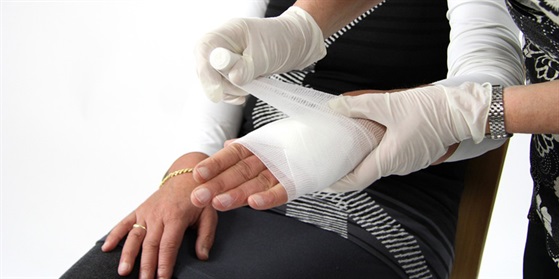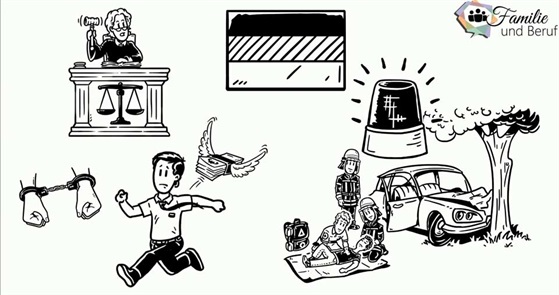First aid
In principle, there is a legal obligation in Germany to provide assistance in an emergency situation. If this emergency assistance is not provided, this can lead to a fine or imprisonment. One should therefore know how this works. If you want to obtain a driving licence in Germany, you must first take a course in "First Aid". Only then will you receive your driving licence after you have passed the driving test.
1. pay attention to safety
In a stressful situation, you often lose sight of your own safety. However, this does not help anyone. Make sure that you can help without putting yourself in danger. In road traffic, secure the vehicle by switching on the hazard warning lights, yourself with a warning vest and the scene of the accident with a warning triangle.
2. check reaction
Are there any casualties? Please note: The injured person should sit or lie down during any assistance. The first-aider stands or kneels in front of or next to the injured person in such a way that he or she can constantly monitor him or her. Check whether the victim is responsive by responding, lightly tapping the cheek or gently shaking. Try to protect the victim from cold or heat depending on the weather. Check the pulse either on the wrist or neck.
Make 3. emergency call (112)
Dial 112 immediately. The emergency number 112 is valid in all European countries. If you are already dealing with the victim, ask other people to help you.
For 112, please provide the following information:
Where is the emergency location?
What happened?
How many people are injured?
What injuries?
Wait for questions!
4. open the airways
Stretch out your head to expose the airways. Hold your ear directly over your mouth to check breathing.
5. missing respiration - mouth to mouth respiration
Carefully turn the victim's body on its back. Kneel sideways at head level next to the victim. Now grasp the victim's forehead with one hand and under the chin with the other and bend the head to the neck to stretch the neck. Then give two breaths through the victim's nose or mouth. Then check the pulse. You can also put your ear on the chest and listen after the heartbeat.
6. breathing present, pulse palpable
Here you can turn the person into a stable lateral position. To do this, they kneel at hip height of the victim. Slide his close arm under his body as stretched as possible. Then place the foot of the near leg against his buttocks. Grasp the shoulder and hips of the far side and turn the victim towards you. The leg serves as a support. Place the fingers of the upper arm under the cheek to stabilize. Ensure that the airways are clear and there is no risk of suffocation should the patient vomit due to collection of fluid in the mouth. To do this, stretch your head over your neck and turn your face earthwards. Monitor the signs of life. Talk comfortingly and calmly to the victim. Tell him that help is about to come.
7. no breathing and no pulse
Start immediately with the heart pressure massage strong and fast. Kneel down next to the victim. Remove or open the clothes on the chest. Place one hand with the ball between the victim's nipples. Place the other hand over it and press with the full force of your upper body. Caution: For toddlers it is better to use a little less force so that no ribs are broken. 30 Heart compressions are followed by 2 respiratory donations. For your peace of mind: Even as an inexperienced first-aider, you do nothing wrong.
8. heavy bleeding
Almost all bleeding wounds can be treated with strong external pressure. Wounds must not be touched, washed out or treated with ointment. If the wound is bleeding heavily, you must press the wound with a clean, sterile cloth or apply a pressure bandage with the help of bandage packs, depending on the size of the wound. Breastfeeding a heavily bleeding wound always has priority in order to reduce blood loss.
9. shock position
If the facial skin of the victim is cold, pale and pale, the pulse is faster and weaker, then a shock position must be established. The victim lies on his back, lift his legs vertically and hold them, then place a suitable piece of luggage under his legs and protect against heat loss with a blanket.
Questions and answers
Can I do something wrong when the chest compressions?
Inexperienced first responders often wonder if they can do any harm. Heart specialists say that it is better to press prefer something more than something less when the chest compressions. In an emergency, a rib could be broken though, but the sufferer is alive.
Should I ventilate when the ambulance takes longer?
Yes definitely. Just the first few minutes can be vital. Always accompany the chest compressions with ventilation.
Checklist
Document
First aid Manual - German statutory accident insurance
Manual with instructions on first aid measures of all kinds
https://dguv.de
First aid measures to revive
In case of unconsciousness or respiratory arrest, quick help is required. This document also with pictures shows you what to do is, if the person concerned is no longer breathing or unconscious.
German Red Cross - https://www.drk.de/
Resuscitation in infants and young children
If the person concerned is an infant or toddler, you need to do the resuscitation a little differently than with a teenager or adult.
German Red Cross - https://www.drk.de/
Helpful Links

First aid - tips and measures
Providing the right help in emergency situations is important. Just a few measures can help in these situations.

Official 24 links emergency and Emergency Call 24
Here you will find a well stocked list of all emergency numbers and emergency calls for each circumstance.

©
first aid 1882053 - aebopleidingen, CC0
Addresses

110 - Polizei Sachsen
Notruf-Nummer: 110
Dresden
🖾
111 - Kinder und Jugendtelefon
0800 111 0333

112 - Feuerwehr und Rettungsdienst
Notruf-Nummer: 112
Dresden
🖾
19222 - Krankentransport
+49 19 222
🖾
116 - Arztbereitschaft
+49 116
🖾
Apotheken-Notdienst
08000022833
🖾
Gift-Notruf
+49 361 730 730
🖾
Notrufnummer des Auswärtigen Amtes
+49 30 181 70

